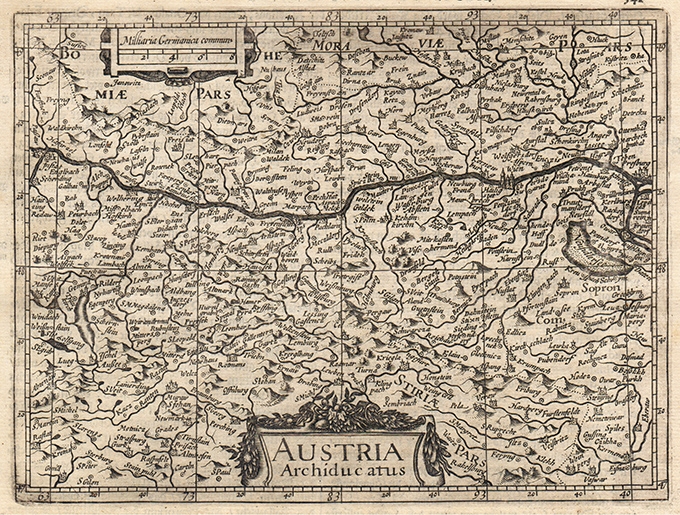Detailed map of Austria centered on the course of the river Danube, between Passau and Bratislava. From the Mercator Hondius “Atlas Minor” published in Amsterdam in 1648 at Jannsonius with german text on verso. In 1607 Jodocus Hondius published a reduced size version of Mercator’s “Atlas”, itself suitably titled “Atlas Minor”. The maps were copied from those of the great cartographer Mercator of around 1580-90 or were reductions of Hondius’ own maps of 1606. Almost 20 years later Joannes Janssonius commissioned a new set of copper plates to be engraved by Pieter Van Den Keere (Kaerius) and Abraham Goos. These maps were elegantly designed with decorative title cartouches, finely engraved and surprisingly detailed for their dimensions. Koeman “Atlantes Neerlandici” Me203.
[Austria] Austria Archiducatus
- Author: MERCATOR Gerard - HONDIUS Henricus
- Year: 1648
- Dimension: 190 x 145 mm
- Place of publication: Amsterdam
€ 120,00
Related products
-
[Russia] Les camps de concentration en Union Soviétique. “Jamais ça en France” Votez Socialiste S.F.I.O.
More Info € 900,00Raro manifesto di propaganda anti-sovietica edito dalla sezione francese dell’unione internazionale dei lavoratori che mostra la rete dei “Gulag”, i campi di prigionia e di lavoro forzato nell’Unione Sovietica. La mappa, che raffigura l’intera Russia dal Mar Baltico allo Stretto di Bering, evidenzia con delle aree in rosso l’ubicazione e l’estensione dei campi di lavoro forzato: con il simbolo della falce e del martello si indicano i campi amministrati localmente, mentre i punti rossi rappresentano i campi sotto il controllo centralizzato. Il primo lavoro di “mappatura” dei gulag sovietici è attribuito ai soldati polacchi Sylvester Mora e Pierre Zwierniak, che per primi disegnarono una carta per accompagnare il loro libro del 1945 Sprawiedliwość Sowiecka (Giustizia Sovietica).
I Gulag furono creati immediatamente dopo la Rivoluzione Russa sotto l’amministrazione di Lenin, presero il nome dall’acronimo della frase russa “Direzione principale dei campi di lavoro correttivi” e nonostante fossero stati pensati per la generalità dei criminali, il sistema è noto soprattutto come mezzo di repressione degli oppositori politici dell’Unione Sovietica. Tutti gli occupanti vivevano in condizioni estremamente difficili, segnate da cibo povero, lavori pesanti e alta mortalità. Dopo la seconda guerra mondiale, le dimensioni e la brutalità del Gulag fornirono molte ragioni alla propaganda anti-sovietica durante la Guerra Fredda.- Author: Isaac Don Levine
- Dimension: 58 x 76 cm
- Year: 1951
-
The map of Austria engraved by G. Bodhener from the rare geographical work Der curiose und .. Nssliche Dollmetscher published in Augsburg in 1748 by Machenbauer. The map has decorative cartouche and a nice original colouring.
- Author: ERDMAN MACHENBAUER J.A.
- Year: 1748
- Dimension: 240 x 170 mm
- Place of publication: Augsburg
-
Miniature map of Pomerania embellished by rich cartouche, vessel and sea monters in the Baltic. From “Theatro del Mondo” the famous plagiarised version of Ortelius’ pocket atlas published specifically for the Italian market by Pietro Marchetti. First printed in Brescia this is the really rare Venetian edition of 1667. [cod.1213/15]
- Author: MARCHETTI Pietro
- Year: 1667
- Dimension: 75 x 105 mm
- Place of publication: Venice
-
Delightful small map depicting present-day Poland and Lithuania. The map is fully engraved with rivers, lakes, forests and mountains and is fi lled with place names. A large, strapwork title cartouche lies in the Baltic Sea. From the Mercator Hondius “Atlas Minor” published in Amsterdam in 1648 at Jannsonius. In 1607 Jodocus Hondius published a reduced size version of Mercator’s “Atlas”, itself suitably titled “Atlas Minor”. The maps were copied from those of the great…
- Author: MERCATOR Gerard - HONDIUS Henricus
- Year: 1648
- Dimension: 195 x 146 mm
- Place of publication: Amsterdam










